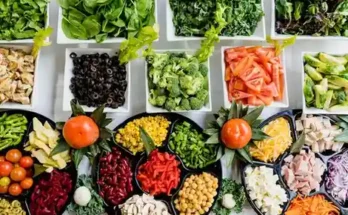Food is more than fuel—it’s culture, comfort, memory, and medicine. But in today’s world, our food choices are becoming increasingly complex, and often, dangerously unhealthy. As convenience replaces tradition and taste wins over nutrition, our bodies are paying the price. We’ll dive into the contrasting worlds of healthy and unhealthy food, understand what we should do after eating, and explore why modern dietary habits are silently sabotaging our well-being.
Healthy Food:
Healthy food is essentially what nature intended—nutrient-dense, minimally processed, and full of life-sustaining vitamins and minerals. It includes fresh vegetables, fruits, whole grains, lean proteins, legumes, nuts, and seeds. These foods are rich in fiber, antioxidants, and essential fatty acids that promote everything from brain function to gut health.
A well-balanced diet can act like a silent guardian of your body. It strengthens the immune system, boosts energy, enhances mental clarity, and reduces the risk of chronic diseases. Think of it this way: every healthy meal you eat is like a deposit in your body’s savings account. The returns? Fewer doctor visits, a sharper mind, and a longer, more vibrant life.
The Silent Culprit:
-
The Rise of Processed Temptations
Unhealthy food, often high in refined sugar, trans fats, sodium, and artificial additives, is increasingly dominating our plates. Fast food, sugary snacks, processed meats, and soft drinks offer immediate gratification but long-term damage. These foods are designed to hijack our taste buds, making it hard to stop after just one bite.
-
Hidden Dangers
While unhealthy food may not show its effects immediately, the consequences pile up quietly over time. High cholesterol, obesity, Type 2 diabetes, fatty liver disease, and even some cancers are directly linked to poor dietary choices. What’s more alarming is that these foods often create a vicious cycle: the more you eat, the more your body craves them, despite the damage being done at a cellular level.
What to Do After Eating?
-
The Post-Meal Pause
What you do after eating is just as important as what you eat. Many people tend to lie down, rush back to work, or dive into digital distractions. However, post-meal habits have a significant impact on digestion and nutrient absorption.
-
Smart Post-Meal Habits
For optimal digestion, consider taking a slow walk after your meal. This helps with blood sugar regulation and supports healthy metabolism. Drinking a small glass of warm water (not cold) can aid in digestion. Avoid sleeping immediately, as it can lead to acid reflux and sluggish metabolism. Allow at least 2–3 hours before lying down after a meal.
Another overlooked habit is mindful breathing. Practicing a few minutes of deep breathing post-meal activates the parasympathetic nervous system, which is responsible for “rest and digest” functions.
A Global Health Crisis:
Non-communicable diseases like heart conditions, obesity, and Type 2 diabetes are on the rise globally, and a large part of the blame lies in the food we consume. The shift from home-cooked, whole foods to quick, processed meals is a major contributor to this health crisis.
The Psychological Connection:
-
Emotional Eating
Another layer to the issue is our emotional relationship with food. Stress, sadness, boredom, and anxiety often drive us toward unhealthy comfort foods. These foods, in turn, give a temporary high followed by guilt and physical crash, creating a harmful loop of emotional dependency.
-
Breaking the Cycle
Understanding that food is not just physical but also emotional is the first step. Developing mindfulness, practicing gratitude before meals, and seeking healthier comfort alternatives can help break the chains of emotional eating. Counseling or therapy may also be helpful for those struggling with deep-rooted eating habits.
Building a Healthier Food Culture:
Family habits influence lifelong food choices. Cooking meals together, involving children in grocery shopping, and teaching them about nutrition can lay a solid foundation for healthier future generations.
Healthy food doesn’t have to be boring. Experiment with herbs, spices, international cuisines, and colorful plating. When healthy meals become a feast for both the eyes and palate, you’re more likely to stick with them. While being health-conscious is good, orthorexia (an obsession with eating only healthy food) is a rising issue. Balance is key. Listen to your body, treat yourself occasionally, but stay committed to nourishing your body most of the time.
Conclusion:
Food is a powerful force. It can be your best ally or your silent enemy. The difference lies in what you choose, how you eat, and what you do after eating. In a world bombarded by unhealthy options and constant distractions, making mindful food choices has never been more important. Take charge. Start with one healthy meal, one mindful habit, and watch how it transforms your life—not just physically, but emotionally and mentally too.
The path to better health isn’t paved with deprivation but with intention. Every bite counts, and every small change matters. Let food be thy medicine—not thy poison.




